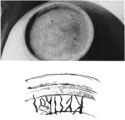VA·1.1
| Inscription | |
|---|---|
| Reading in transliteration: | kasiuos |
| Reading in original script: | |
| Variant reading: | kasiḳos |
|
| |
| Object: | VA·1 Ardena (bottle) (Inscriptions: VA·1.1, VA·1.2) |
| Position: | foot, outside |
| Direction of writing: | sinistroverse |
| Script: | North Italic script (Lepontic alphabet) |
| Letter height: | 1.1 cm0.433 in <br /> |
| Number of letters: | 7 |
| Number of words: | 1 |
| Number of lines: | 1 |
| Workmanship: | scratched after firing |
| Condition: | complete |
|
| |
| Archaeological culture: | La Tène C 2 [from object] |
| Date of inscription: | first half of 2nd c. BC [from object] |
|
| |
| Type: | unknown |
| Language: | Celtic |
| Meaning: | 'Kasiuos' (?) |
|
| |
| Alternative sigla: | Tibiletti Bruno 1981: 21 Solinas 1995: 113 2 Morandi 2004: 41 A |
|
| |
| Sources: | Morandi 2004: 544 f. no. 41 A |
Images
|
| ||||
Commentary
First published in Bertolone 1941: 27 f. Examined for LexLep on 27th January 2022.
Images in Bertolone 1941: 28, fig. 5 (drawing), Tibiletti Bruno 1966: 16 (photo and drawing), Morandi 1999: 173 (drawing) and pl. X.2 (photo = Morandi 2004: tav. IX.41), Morandi 2004: 548, fig. 11.41 (drawing), Rapi 2009b: 213, fig. 1 (photo) and 214, fig. 2 (drawing).
Inscribed on the foot of the bottle, using the rim (top) and a prominent concentric groove (bottom) as guidelines (length ca. 2.5 cm). Final sigma is only slightly curved, somewhat more prominently in the upper area; the reading is supported by the similarly executed first sigma, but see S on inscriptions in which the reading of similar letters as sigma or iota is uncertain. The inscription is impeded by a small pebble which is baked into the clay and must have been there when the letters were applied (cf. Tibiletti Bruno 1966: 17), disturbing letters 5 and 6. The sixth letter omicron is squeezed in above the pebble. The fifth letter was read by Bertolone as kappa ![]() , yielding a linguistically straightforward form kasikos, which is confirmed by Tibiletti Bruno 1966: 15–21 (after autopsy) and repeated by Lejeune 1971: 50, 62, Tibiletti Bruno 1978: 148 f., Solinas 1995: 368 f., no. 113,2, Morandi 1999: 173 f., no. 19, Morandi 2004: 545, Rapi 2009b: 214. However, while small damages below the pebble may suggests the lower tip of a hasta, there is smooth surface between the tip of upsilon and the pebble; no clear trace of a hasta or lower bar to form kappa could be detected above or below the pebble in autopsy. The chevron above the pebble looks more like a small upsilon
, yielding a linguistically straightforward form kasikos, which is confirmed by Tibiletti Bruno 1966: 15–21 (after autopsy) and repeated by Lejeune 1971: 50, 62, Tibiletti Bruno 1978: 148 f., Solinas 1995: 368 f., no. 113,2, Morandi 1999: 173 f., no. 19, Morandi 2004: 545, Rapi 2009b: 214. However, while small damages below the pebble may suggests the lower tip of a hasta, there is smooth surface between the tip of upsilon and the pebble; no clear trace of a hasta or lower bar to form kappa could be detected above or below the pebble in autopsy. The chevron above the pebble looks more like a small upsilon ![]() , inscribed by the writer in the upper part of the line just like omicron. The resulting reading kasiuos is thus epigraphically preferable, but linguistically less plausible than kasikos (see the word pages). It could be considered whether the writer of the inscription intended kappa as the fifth letter, but did not bother to make it more unambiguously legible because he considered the name kassikos to be unambiguously recognisable to contemporary readers; see Salomon 2023: 23.
, inscribed by the writer in the upper part of the line just like omicron. The resulting reading kasiuos is thus epigraphically preferable, but linguistically less plausible than kasikos (see the word pages). It could be considered whether the writer of the inscription intended kappa as the fifth letter, but did not bother to make it more unambiguously legible because he considered the name kassikos to be unambiguously recognisable to contemporary readers; see Salomon 2023: 23.
In either case, the form is a personal name in the nominative, presumably that of the manufacturer, the owner and/or the deceased.
Bibliography
| Bertolone 1941 | Mario Bertolone, "Nuove scoperte archeologiche della provincia di Varese", Rivista Archeologica dell'Antica Provincia e Diocesi di Como 123–124 (1940 [1941]), 21–36. |
|---|



